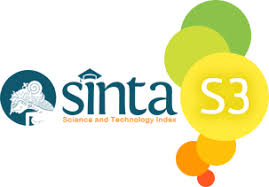Hyperreality on Onlineshop: Shopaholic Generation in Indonesia
 Abstract views: 1176
,
Abstract views: 1176
,
 PDF downloads: 962
PDF downloads: 962
Abstract
Shopping as the lifestyle in Indonesian society has been changed to post-modern era. The shopping moved from retail store or regular shop to online shop. Many online-shop sites, like Mataharimall.com, Tokopedia.com, Blibli.com, Lazada.com, Bukalapak.com, and Elevenia.com make Indonesian society become a shopaholic. The online shop served complete and cheaper goods than the retail shop. Some unique parts are electronics, outfits, even aeroplane tickets and tour packets will be ready in the online shop. The update data mentioned that E-Commerce in Indonesia reached US$1.1 billion. Those are the bigger achieved of Indonesia than Singapore and Thailand in ASEAN (Data by Euro monitor, 2015). Now, Indonesian society entered the new paradigm of consumption. Not only what goods will be consumed, but also how to consume those products. The sensation of shopping, in reality, has been changed with shopping in hyper-reality (virtual world). Today, in Indonesia shopping is not about our needs, but to fulfil our desire. In the postmodern era, the production factor is not a significant factor, but the consumption factor can control the people’s life. The bigger control handled by online media, like Instagram, Facebook and many others. The media can create the attractive display of shop, and it makes shopping lovers a shopaholic. Symbols, signification, codes are relevant in the consumerism era. Therefore, Baudrillard theory about consumptive society became approach and method for this research. The theory will analyse how the online shop as the online media reconstruct Indonesian society became a shopaholic and how the game of symbols, signs, and codes create consumptive behaviour in online shopping. Analysis units of this research are consumptive behaviour and online shop media in Indonesia.
Keywords: Online Shop, Hyperreality, Shopaholic
References
Baudrillard, J., Foster, M. (1975). The mirror of production (Vol. 17). St. Louis: Telos Press.
Baudrillard, J. (1994). Simulacra and simulation. University of Michigan press.
Baudrillard, J. (2005). The Intelligence of Evil or The Lucidity Pact (trans. Turner, T.), New York: Berg.
Baudrillard, J. (2015). Consumer Society: Myths and Structures. Sumrahadi dan Purwanto (Trans.). Masyarakat Konsumsi.. Yogyakarta: Kreasi Wacana.
Bell, D. (2007). Cyberculture Theorist. New York, NY: Routledge.
DBS Group Research. (2015). Indonesia Pusat E-Commerce ASEAN. Retrieved from www. dbsinsights.com/id/digital-dan-inovasi/Indonesia-pusat-e-commerce-asean., accessed 10 May 2017
Hegarty, P. (2004). Jean Baudrillard: Live Theory. London and New York: Continuum.
Hidayat, M.A.. (2012). Menggugat Modernisme: Mengenali Rentang Pemikiran Postmodernisme dan Baudrillard. Yogyakarta: Jalasutra.
Lane, R. J. (2000). Routledge Critical Thinkers for Literary Studies: Jean Baudrillard. London: Routledge.
Lubis, A.Y.. (2014). Postmodernisme: Teori dan Metode. Jakarta: PT Raja Grafindo Persada.
Pawlett, W. (2007). Jean Baudrillard: Against Banality. Peter Hamilton (Ed.). New York, NY: Routledge.
Piliiang, Y.A., Darwin, S. Ade, E.G. (1998). Dunia yang Dilipat: Realitas Kebudayaan Menjelang Milenium Ketiga dan Matinya Postmoderrnisme. Bandung: Mizan.
Piliiang, Y.A.. (2004). Dunia yang Berlari: Mencari Tuhan-Tuhan Digital. Jakarta: PT Grasindo Anggota IKAPI.
Piliiang, Y.A.. (2010). Semiotika dan Hipersemiotika: Kode, Gaya, dan Matinya Makna. Bandung: Matahari.
Ritzer, G. (2003). The Postmodern Social Theory. Muhammad Taufik (Trans). Teori Sosial Post modern. Yogyakarta: Kreasi Wacana.
Riyadi, S., Sufa, S. A., & Susilo, D. Strategic Marketing of Video on Facebook: Impacting Promotion of Malang Strudel Research Brief. Retrieved on: http://repository.unitomo.ac.id/296/1/JOERNAL%20%20Strategic%20Marketing%20of%20%20Video%20on%20Facebook.pdf
Walters, J. (2012). Baudrillard and Theology. Bloomsbury Publishing.
Copyright (c) 2017 Jurnal Komunikasi Profesional

This work is licensed under a Creative Commons Attribution-ShareAlike 4.0 International License.

Jurnal Komunikasi Profesional is licensed under a Creative Commons Attribution-ShareAlike 4.0 International License.
1. Proposed Policy for Journals That Offer Open Access
Authors who publish with this journal agree to the following terms:
- Authors retain copyright and grant the journal right of first publication with the work simultaneously licensed under a Creative Commons Attribution License that allows others to share the work with an acknowledgment of the work's authorship and initial publication in this journal.
- Authors are able to enter into separate, additional contractual arrangements for the non-exclusive distribution of the journal's published version of the work (e.g., post it to an institutional repository or publish it in a book), with an acknowledgement of its initial publication in this journal.
- Authors are permitted and encouraged to post their work online (e.g., in institutional repositories or on their website) prior to and during the submission process, as it can lead to productive exchanges, as well as earlier and greater citation of published work (See The Effect of Open Access).
2. Proposed Policy for Journals That Offer Delayed Open Access
Authors who publish with this journal agree to the following terms:
- Authors retain copyright and grant the journal right of first publication, with the work [SPECIFY PERIOD OF TIME] after publication simultaneously licensed under a Creative Commons Attribution License that allows others to share the work with an acknowledgement of the work's authorship and initial publication in this journal.
- Authors are able to enter into separate, additional contractual arrangements for the non-exclusive distribution of the journal's published version of the work (e.g., post it to an institutional repository or publish it in a book), with an acknowledgement of its initial publication in this journal.
- Authors are permitted and encouraged to post their work online (e.g., in institutional repositories or on their website) prior to and during the submission process, as it can lead to productive exchanges, as well as earlier and greater citation of published work (See The Effect of Open Access).



